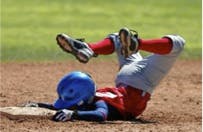High school sports are kicking into high gear and so are many other youth activities. If your child is playing football, soccer, volleyball, running cross country, or participating in any other athletic endeavor – listen up! All athletes are at risk for injury in every sport but there are things you (as an athlete or parent) can do to minimize that risk. This blog isn’t all-inclusive and physical therapists are great resources for athletes. If you are concerned about your athlete getting injured, check out https://www.stopsportsinjuries.org/ for more information on sport specific risk factors and prevention tips. If your child is having pain while they are playing any sport, call us today – they shouldn’t have to play through pain!

There are two general categories of injuries – acute and overuse. Acute injuries are hard to predict and occur suddenly – like rolling your ankle or getting hit with a ball. Overuse injuries occur over an extended period of time, almost creeping up on you – sometimes without warning. Errors in training (over training, under training, inappropriate training…) are the primary cause of overuse injuries, which is a good thing! This tells us that changing training or exercise habits may eliminate the problem and its symptoms (pain!). Overuse injuries are more common in the beginning or end of the season – as you are just getting back into shape or after you’ve been playing hard all season. Tendinitis, golfer’s elbow, little leaguer’s elbow, and shin splints count as overuse injuries (that’s just the tip of the iceberg!) Often imbalances in strength or flexibility are the root of the problem – both things that a physical therapist can identify and correct. If you think you or your child may be at risk for an overuse injury here are a few quick tips:

- Cut back on the duration, intensity, or frequency of your training.
- Use cross training (biking, walking, swimming) to maintain your fitness levels.
- Talk with your coach, trainer, or PT about appropriate training schedules.
- Warm up and cool down.
- Use ice if you have any aches or pains.
If these tips don’t resolve your problem, it is important to get your symptoms addressed quickly! Don’t be afraid to go to the doctor or physical therapist – we want you to be playing just as much as you do! Our goal is to keep you on the field or get you back as fast as possible – without pain!
Erin Bell PT, DPT
Images:
